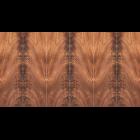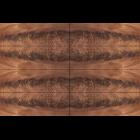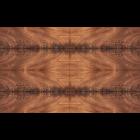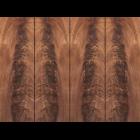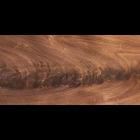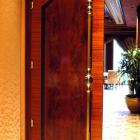Material: Swietenia Macrophylla, "Crotch Mahogany Veneer"
Also knows as: Honduran Mahogany Crotch
Source: Central & South America
Availability: Rare
Description: The Crotch Mahogany veneer figure is a result of the slicing of the portion of a mature Mahogany tree, at the point which the first primary branches evolve from the main trunk. As the branches grow out and up, the growth rings of the tree split to create this unique figure.
The key to the most effective use of this material is the slicing and matching of veneer leaves to take advantage of the patterns generated by the character of the grain. See examples to the Right: All of these layups are from the same starting leaf. Top & bottom examples are "Bookmatch" layups. Second & third are examples of "Book & Butt match" layups. Last photo is the original veneer leaf.
Dimensional Information: Crotch Mahogany veneer leaves are generally anywhere from 6" to 24" in width and in lengths from 24" to 48", with a maximum length of 96" in rare occasions.
Slicing Specifics: Generally, when a section of the tree is identified (graded) to contain a decorative crotch figure, the log section is cut away from the normal trunk and then cut lengthwise into a half log section. The half log section is then cut on a half round slicer (the equivalent of peeling the log). By peeling the veneer sections, the complex figure (grain characteristics) then becomes apparent.
Uses: Decorative veneer suitable for surfaces of furniture, doors, casework, jewelry boxes, music boxes, etc. Coveted by fine woodworkers for centuries, this dramatic material can be manipulated to create outstanding surface patterns and character. Slicing of the veneers into consecutive leaves creates a bundle of material. Clipping and edge matching of leaf segments creates unique decorative patterns, which are demonstrated in the photos to the right.

